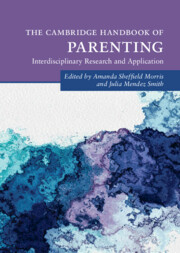Book contents
- The Cambridge Handbook of Parenting
- Cambridge Handbooks in Psychology
- The Cambridge Handbook of Parenting
- Copyright page
- Dedication
- Contents
- Contributors
- Figures
- Tables
- Introduction
- Part I Foundations of Parenting
- Part II Parenting across Development: Social, Emotional, and Cognitive Influences
- 8 Bolstering the Bond: Policies and Programs That Support Prenatal Bonding and the Transition to Parenting
- 9 Parenting during Infancy and Early Childhood
- 10 Parenting That Promotes Positive Social, Emotional and Behavioral Development in Middle Childhood
- 11 Parenting Adolescents
- 12 Parenting during Emerging Adulthood
- Part III Parental Factors That Impact Parenting
- Part IV Child Factors that Impact Parenting
- Part V Parent Education, Intervention and Policy
- Index
- References
8 - Bolstering the Bond: Policies and Programs That Support Prenatal Bonding and the Transition to Parenting
from Part II - Parenting across Development: Social, Emotional, and Cognitive Influences
Published online by Cambridge University Press: 01 December 2022
- The Cambridge Handbook of Parenting
- Cambridge Handbooks in Psychology
- The Cambridge Handbook of Parenting
- Copyright page
- Dedication
- Contents
- Contributors
- Figures
- Tables
- Introduction
- Part I Foundations of Parenting
- Part II Parenting across Development: Social, Emotional, and Cognitive Influences
- 8 Bolstering the Bond: Policies and Programs That Support Prenatal Bonding and the Transition to Parenting
- 9 Parenting during Infancy and Early Childhood
- 10 Parenting That Promotes Positive Social, Emotional and Behavioral Development in Middle Childhood
- 11 Parenting Adolescents
- 12 Parenting during Emerging Adulthood
- Part III Parental Factors That Impact Parenting
- Part IV Child Factors that Impact Parenting
- Part V Parent Education, Intervention and Policy
- Index
- References
Summary
Infants are born predisposed to develop strong relationships to those most likely to protect them; this emotional connection from the child to the protective adult is described as attachment (Ainsworth, 1979; Bowlby, 1983; Crittenden, 2006; Spierling et al., 2019). In turn, parents’ behavioral and physiological responses prime them to respond to attachment behaviors, such as crying, with protective behaviors (Ainsworth, 1979; Bowlby, 1983; Cong et al., 2015). This emotional connection from the attachment figure to the child is described as bonding (Scatliffe et al., 2019). Parental bonding is more often studied in biological mothers, but similar processes of bonding can occur in fathers and other caregivers who act in the role of parents (Bowlby, 1983; Cong et al., 2015; Dayton, Malone, & Brown, 2020). Relationships are a dyadic experience, influenced by both the parent and the child, dynamically changing over time, and shaped by the family context (Ainsworth, 1979; Crittenden, 2006; Wilson et al., 2000). Bonding and attachment are distinct concepts, even though the labels are sometimes used interchangeably (Habib & Lancaster, 2006; McNamara, Townsend, & Herbert, 2019).
- Type
- Chapter
- Information
- The Cambridge Handbook of Parenting , pp. 165 - 190Publisher: Cambridge University PressPrint publication year: 2022
References
- 1
- Cited by

